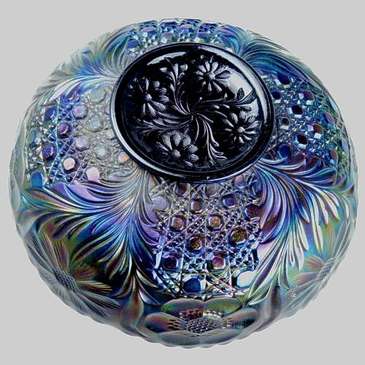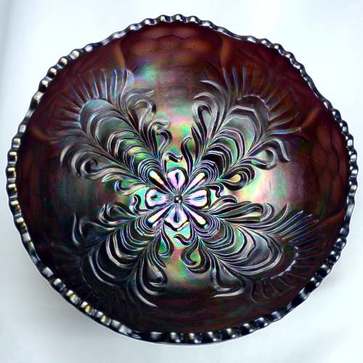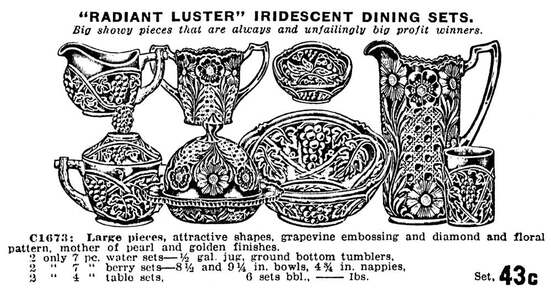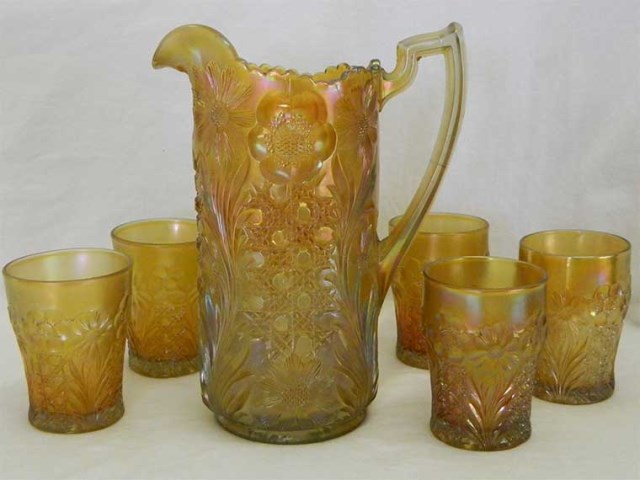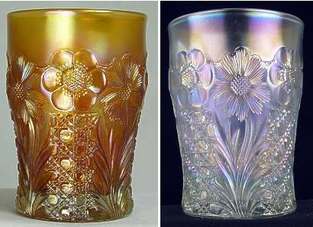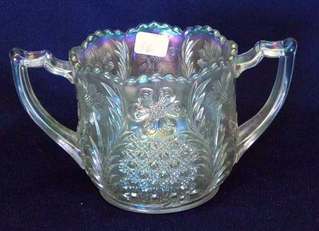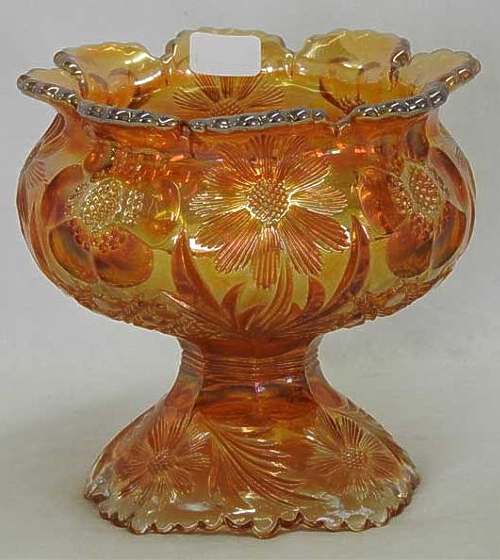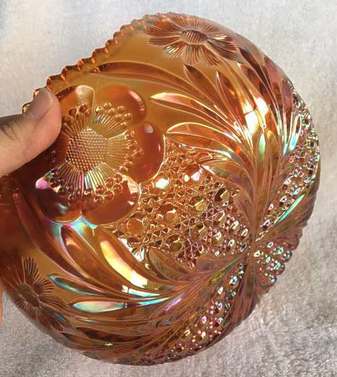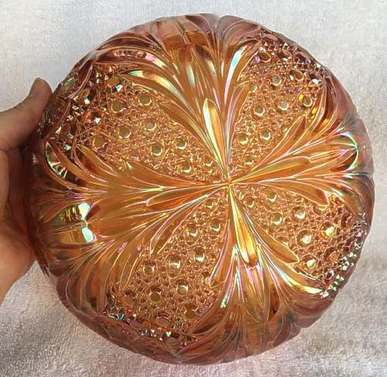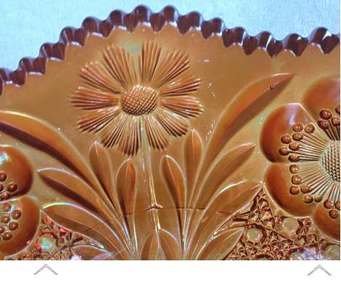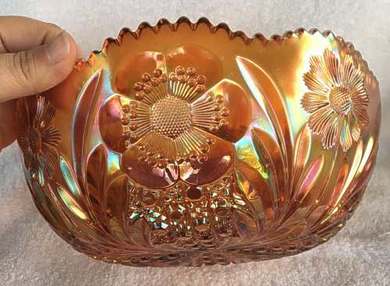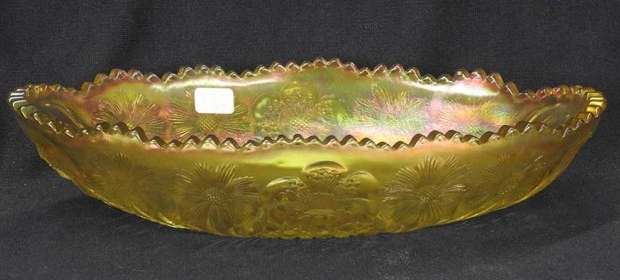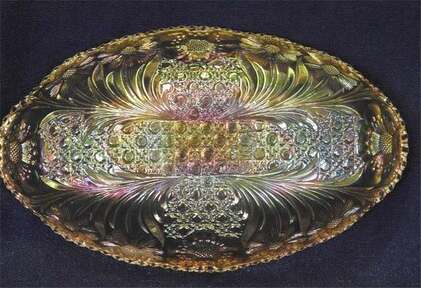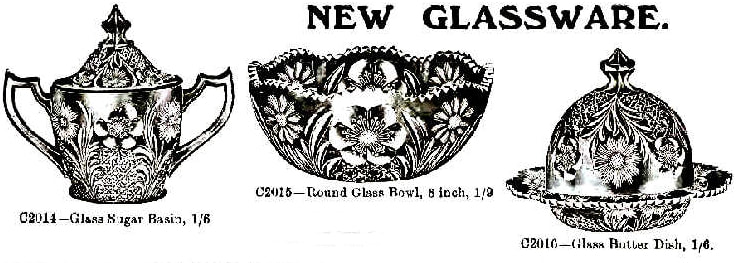Collectors Facts - Cosmos and Cane, United States Glass
Above: a Cosmos and Cane bowl in purple (which is rare for this pattern).
In this case (but not always), there is also an interior pattern - Headdress, shown on the right.
In this case (but not always), there is also an interior pattern - Headdress, shown on the right.
|
Shapes:
See below
|
Colours:
Marigold; honey amber; white (sometimes with a lavender tint), purple (rare)
|
Cosmos and Cane was made in a wide variety of shapes, some of which were whimsied, adding to the variety. The design – a stylised floral and hobnail pattern – is intaglio and exterior. Although only one flower is mentioned in the pattern name, there are two, apparently different flower heads featured in the pattern. On some bowls (as above), the exterior Cosmos and Cane pattern is matched with a Headdress interior design.
Shapes: Bowls in a range of sizes and shapes (including tricorner, square etc). Plates (including 2-sides up and tricorner whimsey). Water set (tumblers may have J.R. Milner Co, Lynchburg, Va advertising moulded on the base – it is interesting to note that the lettering can only be read through the interior of the tumbler, looking through the glass). Table set (four pieces), berry set, breakfast set (sugar and creamer, in a slightly different shape to those in the table set), rosebowls, rare cuspidors and a variety of stemmed (sometimes whimsied) comports.
Shapes: Bowls in a range of sizes and shapes (including tricorner, square etc). Plates (including 2-sides up and tricorner whimsey). Water set (tumblers may have J.R. Milner Co, Lynchburg, Va advertising moulded on the base – it is interesting to note that the lettering can only be read through the interior of the tumbler, looking through the glass). Table set (four pieces), berry set, breakfast set (sugar and creamer, in a slightly different shape to those in the table set), rosebowls, rare cuspidors and a variety of stemmed (sometimes whimsied) comports.
Cosmos and Cane appeared in the April 1912 Butler Brothers wholesale catalogue (above), as part of a "Radiant Lustre" selection. The other U.S. Glass pattern in this assortment is Palm Beach. Note the distinctive Chippendale style handles on the water pitcher and on the handled breakfast sugar.
The reference in the ad to "mother of pearl" would be for white Carnival, and the "golden finishes" would most likely be honey amber.
|
Below (left and centre) are examples of Cosmos and Cane in the two U.S. Glass colours in which it is found most regularly - honey amber and white. The honey amber tumbler on the left has "J.R. Milner Co, Lynchburg, Va" moulded on the base. The white breakfast set sugar has the Chippendale style handles (courtesy Seeck Auctions). On the far right is a marigold spittoon shaped whimsey, or cuspidor (also courtesy Seeck Auctions).
|
Some Clever Mouldwork!
Most Cosmos and Cane items have a collar base (marie), however a few unusual pieces have no marie, but instead, they have a moulded pattern that covers the entire base. Joan Doty reports that "there are some Cosmos & Cane pickle dishes without a marie, or any sort of base".
Here we picture a recent discovery by Lauren Bush: it is a distinctive marigold bowl that features the base design with no marie. Lauren reports that an encircling mould line can be seen around the piece, but no other mould marks are visible. The mould line is shown in the bottom left picture - the line can be seen in a semi-circle between the two ^ marks.
Study of U.S. Glass catalogues from the 1890s show that a number of items were made in this way, with no collar base, so this seems to be a characteristic of the company, used from time to time.
All the pictures below are courtesy and Copyright of Lauren Bush.
Most Cosmos and Cane items have a collar base (marie), however a few unusual pieces have no marie, but instead, they have a moulded pattern that covers the entire base. Joan Doty reports that "there are some Cosmos & Cane pickle dishes without a marie, or any sort of base".
Here we picture a recent discovery by Lauren Bush: it is a distinctive marigold bowl that features the base design with no marie. Lauren reports that an encircling mould line can be seen around the piece, but no other mould marks are visible. The mould line is shown in the bottom left picture - the line can be seen in a semi-circle between the two ^ marks.
Study of U.S. Glass catalogues from the 1890s show that a number of items were made in this way, with no collar base, so this seems to be a characteristic of the company, used from time to time.
All the pictures below are courtesy and Copyright of Lauren Bush.
|
A conundrum solved!
A question that has puzzled Carnival collectors over the years has been why Cosmos and Cane turns up regularly across the other side of the world - in Australia. We found the answer, and published our research in our free NetworK ezine. In short, the United States Glass Company had a branch office and showroom in Sydney, Australia. This enabled them to get their glas1912 ware to the Australian market in a timely fashion - as evidenced by their Cosmos and Cane pattern, which was introduced to the domestic US market in early 1912, appearing in the 1912 catalogue of a major Australian retail store - Foy & Gibson - in the same year. The full story is here: NetworK #70 |
Cosmos and Cane pieces offered in this 1912 Foy & Gibson catalogue extract.
|
What’s in a Name
The pattern name Cosmos and Cane was chosen by Carnival Glass pioneer, Marion Hartung, back in 1962, in her Book III. As it has turned out, the name used by Hartung has become the one generally used by Carnival collectors, which is indeed very fortunate!
The other well-known pioneer, Rose Presznick, got herself rather confused by the way the appearance of the pattern differed slightly as it was altered by the maker to fit the various shapes, and she consequently gave this pattern at least three different names!
In Presznick Book II (1966), a covered sugar was illustrated, and the name given to the pattern was “Diamond Point and Daisy” aka “Waffle and Daisy”. The maker was “unknown” and the shapes listed were bowls, table set and water set.
In Presznick Book IV (1967), things got more muddled, as a cuspidor was illustrated, and the pattern name given was “Little Daisy” (listed in the text as “Little Daisy Varient”), known in one shape only, which was the little cuspidor. The accompanying text was interesting: “the pattern is like little diamonds and beads between the flowing leaves. The shaggy daisies are in a band just under the top rim – deep scallops. Some oldsters call this a pansy vase. Assumed to be Fenton”.
The situation became even more complex when the tumbler in this pattern was featured in the Souvenir section (with the J.R. Millner advertising) and it was given the name “Paneled Daisy and Cane (Varient)”. (There was also another entirely different pattern listed as “Paneled Daisy and Cane” basket which is the name we know that basket by today). The tumbler was also listed again under the name “Millner Co.”
The pattern name Cosmos and Cane was chosen by Carnival Glass pioneer, Marion Hartung, back in 1962, in her Book III. As it has turned out, the name used by Hartung has become the one generally used by Carnival collectors, which is indeed very fortunate!
The other well-known pioneer, Rose Presznick, got herself rather confused by the way the appearance of the pattern differed slightly as it was altered by the maker to fit the various shapes, and she consequently gave this pattern at least three different names!
In Presznick Book II (1966), a covered sugar was illustrated, and the name given to the pattern was “Diamond Point and Daisy” aka “Waffle and Daisy”. The maker was “unknown” and the shapes listed were bowls, table set and water set.
In Presznick Book IV (1967), things got more muddled, as a cuspidor was illustrated, and the pattern name given was “Little Daisy” (listed in the text as “Little Daisy Varient”), known in one shape only, which was the little cuspidor. The accompanying text was interesting: “the pattern is like little diamonds and beads between the flowing leaves. The shaggy daisies are in a band just under the top rim – deep scallops. Some oldsters call this a pansy vase. Assumed to be Fenton”.
The situation became even more complex when the tumbler in this pattern was featured in the Souvenir section (with the J.R. Millner advertising) and it was given the name “Paneled Daisy and Cane (Varient)”. (There was also another entirely different pattern listed as “Paneled Daisy and Cane” basket which is the name we know that basket by today). The tumbler was also listed again under the name “Millner Co.”
See more Collectors Facts
